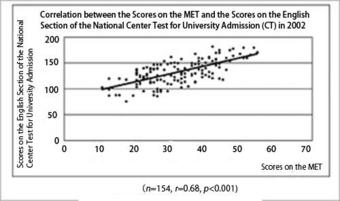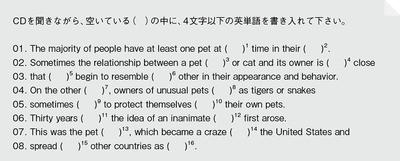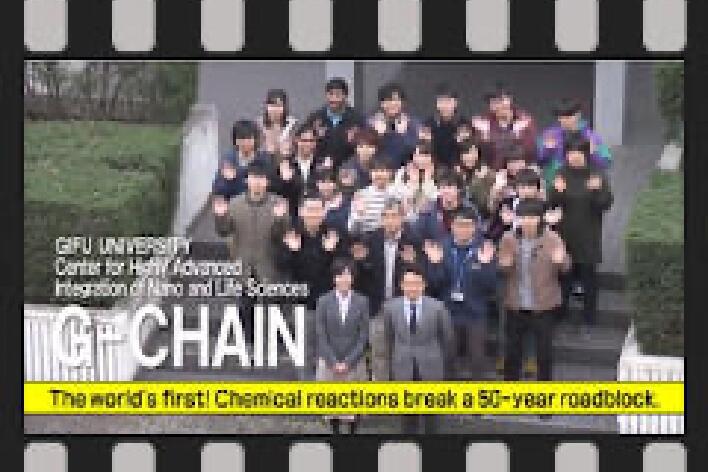Dr. Maki developed the Minimal English Test (MET) to increase efficiency in education and research in the field of acquisition of English as a foreign language, and has published a book on the MET research.
*Information related to faculty members/students and graduate schools at Gifu University here are all that of the time of interviewing.

I first developed the Minimal Japanese Test (MJT) to assess the Japanese proficiency of American learners of Japanese, while I was teaching at Salem-Teikyo University in the United States.

After obtaining a degree from the University of Connecticut (U.S.) in the field of linguistics advocated by Dr. Avram Noam Chomsky (1928- ), I taught Japanese to undergraduate students at Salem-Teikyo University (presently Salem University, West Virginia, U.S.) for seven years. While attending a conference of the Association of Teachers of Japanese, I encountered the Tsukuba Test-Battery of Japanese (TTBJ) and the Simple Performance-Oriented Test (SPOT), both of which are designed to evaluate the Japanese language proficiency of learners of Japanese.
However, it takes 150 minutes to conduct the TTBJ, while it only takes two minutes to conduct the SPOT. In the SPOT, test participants are asked to fill in one hiragana letter for each blank while listening to a Japanese sentence (e.g., 「明日は大事( )用があって、行けません(translated as "I cannot go because I have an important appointment tomorrow.")」 The correct answer is "な."). Results showed, however, that there was a strong correlation between the scores on the TTBJ and the scores on the SPOT (with a correlation coefficient of about 0.9), which suggests that it is possible to accurately assess the Japanese language proficiency of learners within a few minutes. The remarkable efficiency of the SPOT inspired me to develop my version of the SPOT, which I called the Minimal Japanese Test (MJT). The correlation coefficient between the scores on the MJT and the scores on the Level 3 of the Japanese-Language Proficiency Test (JLPT) was about 0.8, which proves that the MJT is quite useful as a predictive language assessment tool for the JLPT for American learners of the Japanese language.
The MET can be viewed as a "litmus test" in English language education, and can be widely utilized by educators, researchers and learners of English around the world.

Scores on the English Section of the National Center Test for
University Admissions (CT) in 2002
In 2002, I relocated to Gifu University, and began further work on the development of a test which can efficiently and accurately measure the English proficiency of Japanese learners of English within minutes. First, I created a five‒minute English test, referred to as the Minimal English Test (MET), which requires the test taker to complete 72 given sentences by writing a correct English word with a maximum of 4 letters in the blank spaces provided, while listening to a corresponding CD. The MET is based on Lessons 1 and 2 of the textbook and accompanying CD This is Media.com written by Kawana and Walker (2002) for the first year university students. Based on my research findings, there is a relatively strong correlation between the scores on the MET and the scores on the English section of the National Center Test for University Admissions (see Graph 1). Since then, more than 10,000 data samples related to correlations among the scores on the MET, the English section of the National Center Test for University Admissions and the TOEIC have been accumulated over the past 16 years. Data suggests that the scores on the MET and the total scores on the English section of National Center Test for University Admissions had the highest correlation coefficient among the three correlation coefficients (the one with the total scores, the one with the scores on the reading section and the one with the scores on the listening section), which indicates that the MET actually measures the sum of the reading comprehension and the listening comprehension, not just either one of them.
【Merits of the MET】
1. Easy to Create
The latest version of the MET follows a simple rule that every 6th word is a target word. Therefore, given English sentences and the audio data, anyone can readily devise their own version of the MET. Furthermore, it is also possible to design different versions of the MET with the same sentences by altering the positions of the target words.
2. Time-Saving
It only takes five minutes to conduct the MET. Therefore, there is little burden on the test takers, and at the same time, researchers on English education can easily obtain reliable data.
3. Effective
The MET resembles a game which increases learner motivation to acquire higher scores. In addition, the MET has a "practice makes perfect" effect, which induces an incentive among the test takers to improve their test scores by repeatedly attempting different versions of the MET.
4. Reliable
My research over the past 16 years is based on more than 10,000 data samples, and the results have consistently indicated that the MET is a reliable measure of the English proficiency of language learners.
The MET is still at the developmental stage. The original version of the MET targeted the correct responses consisting of 4 letters or fewer, but the latest version of the MET follows a simple rule that every 6th word is a target word, regardless of how long the correct word may be. It is worth noting that the other versions of the MET I created where every 8th or 10th word was a target word and the original version of the MET resulted in no significant differences in terms of the correlations between their scores and the scores on the English section of the National Center Test for University Admissions. The latest version of the MET contains about 70 blanks on one sheet of A4 size paper (8.3x11.7 in), and it only takes three minutes to administer. In this sense, the MET is a "litmus test" in English language education, as it can assess the English language proficiency of learners of English within a short span of time (i.e. three minutes).
Alternatively, it is also possible to create different versions of the MET with the same sentences by simply changing the positions of the target words. Furthermore, the MET has a "practice makes perfect" effect, which means that it is possible for the test takers to obtain higher scores (i.e. improve their test scores) by repeatedly trying various versions of the MET. The "junior" Minimal English Test (jMET) for junior high school students was also devised and conducted. Test participants enjoyed taking the jMET, as it evoked a sort of game playing. If the MET is language learner-friendly, it can also be assumed that it is educator-friendly, as the test induces a fun game-like element for the learners, and an efficient and effective language assessment tool for educators. Note that anyone can freely use the different versions of the MET included in my book.
The Minimal Korean Test (MKT) and the Minimal Chinese Test (MCT) are currently in the works as well, which I am sure will contribute to the field of foreign language education.

Written by Hideki Maki
Published by Kaitakusha in 2018
Price: 3,800 (tax excluded)
This book illustrates the merits of the MET. The
versions of the MET and the accompanying CD
are freely available to all users. The book also
includes the versions of the MET based on the
past National Center Tests for University
Admissions.






